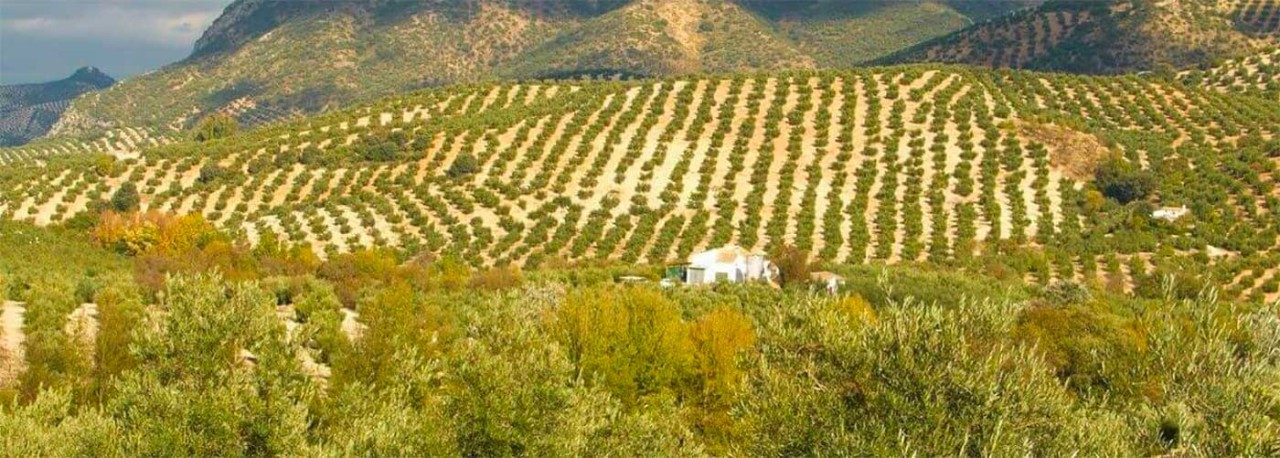.png.transform/rendition-xs/image_image%20(1).png)
Aceite de Jaén PGI
Extra virgin olive oil obtained from the fruit of the following varieties of olive tree: Picual as main variety and Manzanilla de Jaén, Royal de Cazorla and Carrasqueño de Alcaudete, Hojiblanca, Arbequina and Picudo as secondary varieties.
Tasting notes
Aroma: a perceptible aroma of fresh, healthy olives with hints of vegetables or other plant-based products such as green leaves or grasses, combined with distinctively fruity notes which are moderately to heavily pronounced (median for fruitiness on a continuous linear scale greater than 3).
Taste: clean, fragrant taste of fresh, healthy olives with bitter, pungent notes of the following intensity:
Bitterness: moderately or clearly perceptible (median on a continuous linear scale between 3 and 6,5),
Pungency: moderately or clearly perceptible (median on a continuous linear scale between 3 and 6.5).
Other notes
In short, the organoleptic characteristics of the oils covered by the ‘Aceite de Jaén’ designation are defined by aromas of fresh, clean and healthy olives picked before 31 December, when the bitterness and pungency attributes are highly pronounced.
Production / Processing methodAceite de Jaén is produced in any of the following 97 towns in the Jaén province: Albanchez de Mágina, Alcalá la Real, Alcaudete, Aldeaquemada, Andujar, Arjona, Arjonilla, Arquillos, Arroyo del Ojanco, Baeza, Bailén, Baños de la Encina, Beas de Segura, Bedmar y Garcíez, Begíjar, Bélmez de la Moraleda, Benatae, Cabra de Santo Cristo, Cambil, Campillo de Arenas, Canena, Carboneros, Cárcheles, Castellar, Castillo de Locubín, Cazalilla, Cazorla, Chiclana de Segura, Chilluévar, Escañuela, Espelúy, Frailes, Fuensanta de Martos, Fuerte del Rey, Génave, Guarromán, Higuera de Calatrava, Hinojares, Hornos, Huelma, Huesa, Ibros, Iznatoraf, Jabalquinto, Jaén, Jamilena, Jimena, Jódar, La Carolina, La Guardia de Jaén, Lahiguera, La Iruela, La Puerta de 3 Segura, Larva, Linares, Lopera, Los Villares, Lupión, Mancha Real, Marmolejo, Martos, Mengíbar, Montizón, Navas de San Juan, Noalejo, Orcera, Peal de Becerro, Pegalajar, Porcuna, Pozo Alcón, Puente de Génave , Quesada, Rus, Sabiote, Santa Elena, Santiago de Calatrava, Santiago-Pontones, Santisteban del Puerto, Santo Tomé, Segura de la Sierra, Siles, Sorihuela del Guadalimar, Torreblascopedro, Torredelcampo, Torredonjimeno, Torreperogil, Torres, Torres de Albanchez, Úbeda, Valdepeñas de Jaén, Vilches, Villacarrillo, Villanueva de la Reina, Villanueva del Arzobispo, Villardompardo, Villarrodrigo y Villatorres.The harvesting period – for both the main variety and those others – commences in October in the case of oils that are harvested ‘green’ or as ‘early oils’ and ends in late December when the ripest olives are harvested.
Geography / Relief and climate
Olive plantations cover a surface area of 582 427 hectares in Jaén province (89,75 % of cultivated land) divided into over 100 000 holdings, of which 76 % are smaller than 5 hectares. Olive-growing is not just a source of income for most families in Jaén but also part of their socio-cultural heritage. Olive-growing and olive oil production are present in the 97 municipalities in the province. Olive trees are grown in every one of them and all except for three have at least one olive mill. This proves that the entire province of Jaén is directly linked and involved in producing the product.The olive-lined landscape of Jaén is the result of the age-old interplay between the geomorphology of the province and the attempts made by its human inhabitants to harness the territory, aided by the physical environment. The particular relief to be found in the province means that the cultivated area is located between Marmolejo (altitude 250 m) and Noalejo (1 000 m).The olive-growing soils in Jaén province are clearly similar to the inceptisol (USDA) or cambisol and regosol (FAO) soil types, all of which have a distinctively high calcium carbonate content and therefore a high pH ranging between 6 and 8.Moreover, as the province is located in the very heart of the Mediterranean area, it offers ideal climatic and temperature conditions and rainfall patterns that are mostly optimal for olive-growing (Csa in the Köppen climate classification). The average mean temperatures range between 14,5 °C and 17 °C. The maximum mean temperatures in summer are over 30 °C (around 35 °C in July and August) and the minimum mean temperatures in the winter months are about 2° or 3 °C. The average thermal range recorded is 13 °C. Average annual rainfall is about 410 mm-620 mm, albeit with the significant variations from year to year which are typical of the Mediterranean climate. In the last 20 years, rainfall has been low (about 475 mm per year), more abundant in autumn than in winter and springtime, and very scarce in the summer months (less than 10 % of total annual precipitation). In short, the summers are very dry and with low rainfall, with very high maximum temperatures, a high level of sunshine and minimum relative humidity below 20 %.The typical environment in the production area for ‘Aceite de Jaén’ and more specifically, the altitude, the limestone soils with high levels of carbonate compounds and the climate (high temperatures and almost no rain in summer and the annual rainfall pattern) make it possible to link the characteristics described in point 3.2 to the geographical environment. These conditions mean that olives grown without irrigation suffer water stress, which leads to oils with a higher concentration of polyphenols, tocopherols and oleic acid, with very pronounced scores for the sensorial attributes of bitterness, pungency and fruitiness. Even irrigated olive plantations, where stress levels are maintained due to irrigation being insufficient, oils also present medium to high levels of polyphenols, as well as greater stability and intensity in the fruitiness, bitterness and pungency attributes than those obtained from FAO or high-dose water irrigation (Salas et al, ‘Influencia del riego sobre la composición y características organolépticas del aceite de oliva [The influence of irrigation on the composition and organoleptic characteristics of olive oil]’Grasas y Aceites, vol. 48, Fasc. 2, 1997, pages 74 and 82).
Regulatory Council
Junta de Andalucía
www.juntadeandalucia.es
Sources:
- Spanish Ministry of Agriculture


Jaén (Andalusia)
